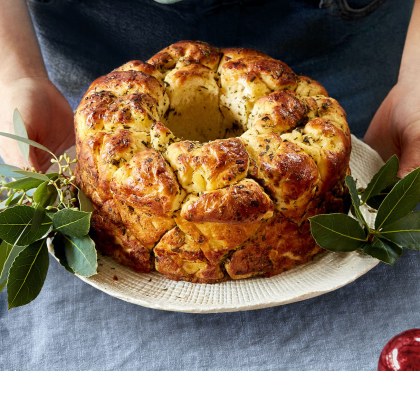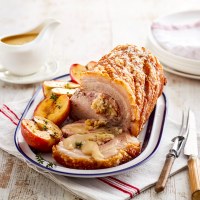How to make homemade garlic bread from scratch
This homemade garlic bread pull-apart is extra golden, crunchy and flavourful thanks to an easy potato dough, plus extra herbs and spices in the garlic butter. Learn how to make it and get all the tips and tricks for the most flavourful garlic bread.
Garlic Bread Pull-apart recipe
INGREDIENTS
- 1 head of garlic
- 1 kg starchy potatoes
- 1 ½ cups of full cream milk
- 75g Western Star Salted Butter
- 1 ½ tbsp caster sugar
- 3 tsp instant dry yeast
- 4 ½ cups plain flour
- 3 eggs
- ¼ cup each of fresh sage, thyme, parsley and rosemary leaves, finely chopped
- 100g Western Star Salted butter, melted
METHOD
- Preheat oven to 200°C. Using a fork prick the potatoes all over and place onto a baking tray. Roast for 1 hour or until tender. Scoop potato from the skins and leave to cool
- While the potatoes are cooking cut the top off a whole head of garlic and drizzle with olive oil. Wrap in foil and place into the oven for 30-40 mins. Cloves should be soft and lightly browned. Squeeze garlic from cloves and place with potatoes
- Place half of the milk into a small saucepan and bring to the boil. Remove from heat and add the butter and sugar. Once butter is melted add the remaining milk and yeast, stir to combine. Set aside for 5 mins
- Place the flour, eggs, and milk mixture into the bowl of an electric mixer fitted with a dough hook and mix for about 5 mins or until dough is smooth. Transfer dough to a lightly oiled bowl, cover with glad wrap and leave in a warm place to rise for 30-40 mins. It should almost double in size
- Add the potato and garlic to the dough and knead to combine. Roll the dough into 1 tbsp portioned balls
- Line a 23cm round cake tin with baking paper, allowing 4cm to sit above the tin. Grease a ramekin that is at least 8-10 cm tall and 8 cm wide and place into the centre of the tin. Melt the butter in a small bowl and combine with chopped herbs. Roll the balls of dough in the herb mix and place into the cake tin. Cover with glad wrap and place in a warm spot for 30 mins or until risen
- Preheat oven to 180°C and bake bread for 20-25 mins, until golden and cooked through. Remove ramekin and allow to cool for 10 mins before turning out. Serve with lemon garlic butter
Serve with lemon garlic butter, made with 150 g of softened Western Star Salted Butter, zest of 1 lemon, 1 small crushed clove of garlic and pepper stirred together to taste.
Get the recipe you can save to your myfoodbook cookbooks here: Sage, Thyme and Roasted Garlic Bread Wreath
How to make potato bread dough
This recipe uses a potato dough, adding potato to a bread dough adds extra flavour, creates a light and tender crumb, as well as a very crisp crust. Making potato dough is just as easy as making any other dough, but there are a few tips to ensure it comes out perfectly.
1. Use a starchy potato
What is a starchy potato? Starchy potatoes, also called floury potatoes, include varieties such as Coliban, Sebago, Dutch creams and King Edward. Or, look for potatoes that say they're ‘good for mashing’. High in starch and low in moisture, their floury texture is the best for mashing as they break down easily, and the best for breads as they don't add excess moisture to the dough.
2. Roast the potatoes
Ensure you roast the potatoes, don't boil or steam them. Roasting potatoes whole cooks them without adding extra moisture, which is important for the dough.
Leave the skins on and prick the potatoes all over with a fork. The hot oven boils the water within the potato’s cells, and pricking the skins allows the steam to be released.
Alternatively, cook potatoes in the microwave. Most microwaves have a cook potato setting for jacket potatoes. Otherwise, prick potatoes all over, place onto the turntable and cook on HIGH for 10 minutes. Check for tenderness (being careful of hot steam), and cook for a further 3 minutes if required. Repeat in 3 minute intervals until potato is cooked. They will be extremely hot, let cool for at least 10 minutes before handling.
3. Roast the garlic
Roasted garlic is an excellent way of adding another depth of flavour to your breads. Roasting garlic with oil and tightly wrapped in foil transforms it into a soft, caramelized creamy texture with a sweet and mellow flavour.
Alternatively, try adding a heaped tablespoon of fermented black garlic instead of roasted garlic for a similar flavour with a gorgeous dark colour.
4. Heat the milk mixture
Carefully follow the instructions to only boil half the milk and take it off the heat before adding the butter, sugar and the rest of the milk. Add the yeast last, when the mixture is only lukewarm, or the high heat will kill the yeast and the dough won't rise.
Milk and butter will enrich the dough, giving it a fantasic flavour, tender crumb and golden colour once baked.
5. Prepare the pan
Follow the instructions in the recipe to create your own wreath shape by simply using a cake pan with a ramekin in the centre. If you have a bundt pan, you could use that instead. Or, simply pile the bread dough into a cake pan. It won't be a wreath shape, and fewer of the dough pieces will become baked and golden on the outside, but it will be just as enjoyable. Remember to increase the cook time to ensure the dough in the centre is cooked.
Line and butter the pan thoroughly to ensure the bread doesn't stick.
6. Experiment with different herbs
Try using a mix of your favourite fresh or dried herbs. Give these combinations a try:
- Rosemary and chilli flakes
- Basil, lemon zest and chives
- Parsley, thyme and pepper
- Dill and tarragon
More recipes
Want more baking and dinner party recipes? See below for more ideas for entertaining.



















